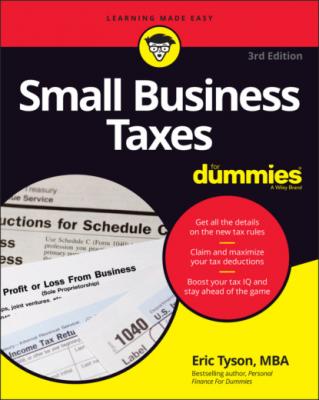Small Business Taxes For Dummies. Eric Tyson
Читать онлайн.| Название | Small Business Taxes For Dummies |
|---|---|
| Автор произведения | Eric Tyson |
| Жанр | Бухучет, налогообложение, аудит |
| Серия | |
| Издательство | Бухучет, налогообложение, аудит |
| Год выпуска | 0 |
| isbn | 9781119861164 |
Neglecting the timing of events you can control
Or suppose that you operate on a cash accounting basis and think that you’ll be in a lower tax bracket next year. Perhaps business has slowed of late or you plan to take time off to be with a newborn or take an extended trip. You can send out some invoices later in the year so that your customers won’t pay you until January, which falls in the next tax year.
Not using tax advisors effectively
As a small business owner, ask yourself how much you’re worth running your business versus how much you’re worth as a bookkeeper. Then ask yourself which task you enjoy more and consider hiring a bookkeeper.
Note that using a tax advisor is most beneficial when you face new tax questions or problems. If your tax situation remains complicated or if you know that you’d do a worse job on your own, by all means keep using a tax preparer. If your situation is unchanging or isn’t that complicated, consider hiring and paying someone to figure out your taxes one time. After that, go ahead and try completing your own tax returns.
Noting How Corporate and Individual Tax Reform Impacts Small Business
Corporate tax reform in the United States was long, long overdue. For too many years, corporations in the United States faced a much higher corporate income tax rate than did companies based in most overseas economies. As a result, increasing numbers of U.S. companies had chosen to expand more overseas rather than in the United States and to be headquartered outside of the United States, which wasn’t good for the long-term health of the U.S. economy and labor market.
Congress passed the Tax Cuts and Jobs Act in late 2017, which took effect with tax year 2018. It was the most significant tax reform package passed since the Tax Reform Act of 1986. What follows are the highlights of the most significant provisions that affect (and mostly benefit) small business.
Checking out corporate income tax rate reduction and simplification
At 35 percent, the United States had had one of the highest corporate income tax rates in the world before 2018. The Tax Cuts and Jobs Act slashed the corporate income tax rate to 21 percent, which represented a 40 percent reduction.
The corporate tax rules and deductions were simplified, including eliminating the corporate alternative minimum tax and closing some loopholes. The United States also moved to a territorial tax structure whereby U.S. companies would no longer pay a penalty to bring their overseas profits back home. The immediate impact of this change was to enable U.S. corporations to bring back to the United States more than $2 trillion being kept overseas to avoid excessive taxation.
The vast majority of small businesses aren’t operated as traditional so-called C-corps (more on those in a moment). Most small business owners operate as sole proprietorships (filing Schedule C), LLCs, partnerships, or S corporations. In those cases, the business owner’s profits from the business generally flow or pass through to the owner’s personal income tax return, and that income is taxed at personal income tax rates (see the section “Noting 20 percent deduction for pass-through entities” for more information).
Reducing individual income tax rates
Just as the corporate income tax rate was reduced by the Tax Cuts and Jobs Act legislation, so too were the individual income tax rates. Most of the tax bracket rates were reduced by several percentage points (see Table 1-1). This, of course, is excellent news for the vast majority of U.S. small business owners who operate their businesses as pass-through entities (for example, sole proprietorships, LLCs, partnerships, S-corps).
TABLE 1-1 2022 Federal Income Tax Brackets and Rates
| Federal Income Tax Rate | Single Taxpayers Taxable Income | Married Filing Jointly Taxable Income |
|---|---|---|
| 10% | $0 to $10,275 | $0 to $20,550 |
| 12% | $10,275 to $41,775 | $20,550 to $83,550 |
| 22% | $41,775 to $89,075 | $83,550 to $178,150 |
| 24% | $89,075 to $170,040 | $178,150 to $340,100 |
| 32% | $170,040 to $215,950 | $340,100 to $431,900 |
| 35% | $215,950 to $539,900 | $431,900 to $647,850 |
| 37% | More than $539,900 | More than $600,000 |
Note that at higher levels of income, the individual income tax rates begin to exceed the 21 percent corporate tax rate. Seeing this helps you to better understand the next point as to why pass-through entities are being granted a special tax deduction on their profits.
Noting 20 percent deduction for pass-through entities
In redesigning the tax code, Congress rightfully realized that the many small businesses that operate as so-called pass-through entities would be subjected to higher federal income tax rates compared with the new 21 percent corporate income tax rate. Pass-through entities are small business entities such as sole proprietorships, LLCs, partnerships, and S corporations and are so named because the profits of the business pass through to the owners and their personal income tax returns.
To address the concern that individual business owners who operated their business as a pass-through entity could end up paying a higher tax rate than the 21
